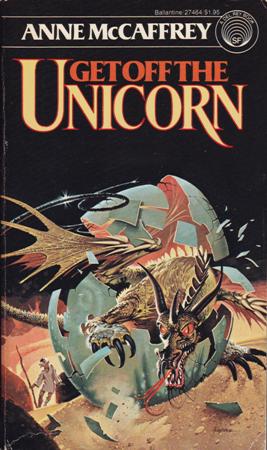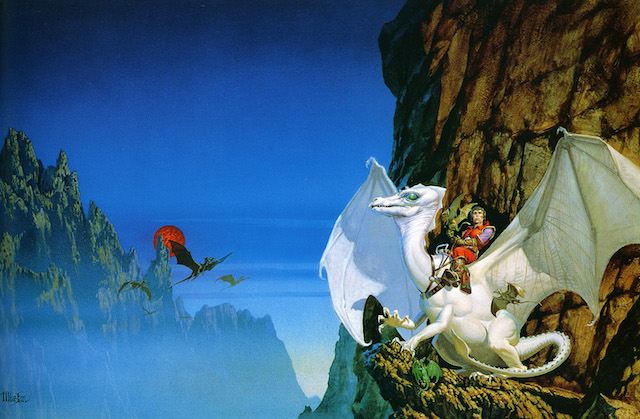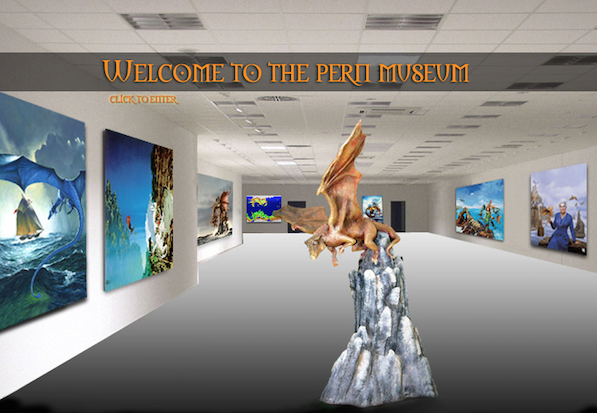Do you remember growing up, how your mother would always say, “Don’t judge a book by its cover”? Of course, she was referring to that weird lab partner you were always complaining about, but the principle has much broader applicability, because when I picked up Get Off The Dragon, I literally judged the book by its cover. And I’m going to be honest and say I was less than thrilled to have to read it for my Sword and Sorcery class. I have never been one to read fantasy fiction for pleasure or even consider reading science fiction work. I find the make-believe, magic, dragons and whatever else you want to classify as “fantasy” completely boring and unrealistic. But, after reading Get Off The Dragon, I have to give Anne McCaffrey serious props. The book was well written and not too long, and although many would classify her writing in the fantasy realm, I would say it’s more futuristic than anything, which helped make it more interesting to read. Many of the stories in this collection are believable, and if they aren’t, they are too entertaining to care! So, I’ll admit I was wrong to judge her book by the cover, but if I’m being honest, the book’s cover cover isn’t particularly representative of the content anyway.
Let’s start with the cover art. We have, a ferocious dragon breaking through the fragile walls of its shell, with a sickly boy covered in bloody bandages stumbling in the background. There are no signs of females or horsemen, or unicorns for that matter, which seems strange considering the title of the book is Get Off The Unicorn. Originally, Anne McCaffrey planned to title her book Get Of The Unicorn, meaning the offspring of a particular animal. In her introduction, she informs her readers that the mistake “although it fits most of the stories if you know the old tale about unicorn-bait, comes from a misprint in the Ballantine roster of unfilled contracts.” The publishing company, Ballantine, had accidentally printed her book with the wrong title, and rather than changing it, she just went with it.
Interestingly, the two titles appear to contradict themselves. While Get Off the Unicorn hints at the idea of removing oneself from the mythical creature, Get Of The Unicorn refers to the continuation of the species through reproduction. A contrasting parallel is drawn by this mistake, but one has to wonder, what is the symbolism behind the “unicorn” McCaffrey references? Why a unicorn? There are literally no unicorns in any of the stories in this collection, so why title it that? Traditionally, unicorns have appeared as a symbol of chastity and an emblem of God, embodying a sense of mystery and divinity. They are usually white, which hints at their innocence and perfection, as well as their purity and virginity. When Get Off The Unicorn was being published in the 1970’s, Robert E. Howard’s Conan stories were extremely popular in the sword and sorcery genre, depicting images of masculinity, grit, and bloodshed. Perhaps McCaffrey was trying to shift the focus and content of current fantasy /science fictions books from blood and gore to a gentler world with humanistic and relatable content? Being a female writer, it could also be that she wanted to create a gender-friendly fantasy world, one without the hypermasculinity that was so common in Howard’s books.
Published in 1977, at the height of the sword and sorcery craze, Get Off The Unicorn is a collection of short stories, most of which were previously published in science fiction magazines and fantasy anthologies. Many would also later come to be incorporated into larger fictional projects. “Lady in the Tower,” first published in a 1952 issue of The Magazine of Fantasy and Science Fiction, is one of McCaffrey’s earliest stories. After its publication in Get Off the Unicorn, she would return to it as the basis for her 1990 novel The Rowan, the first book in a continued series about telepathy, psycho-kinesis, and other psychic talents. “The Smallest Dragonboy,” a standalone story originally published in Science Fiction Tales in 1973 and again in 1977 in Creatures of the Cosmos, later became part of the McCaffrey’s famous and long-running Dragonriders of Pern series (consisting of more than twenty-two books!) in a collection titled A Gift of Dragons in 2002.

An Author at the Top of Her Game
Aesthetically, Get Off The Unicorn looks grungy. The cover art isn’t particularly captivating and, as I’ve noted above, has no connection to the title. The misprint makes it clear that the book was significantly less important than McCaffrey’s other works. Why then did Ballantine publish it in the first place? Interestingly, McCaffrey actually acknowledges the book’s insignificance. In her introduction she writes, “Most of you kind people who are buying this volume will have done so because of the author’s name on the cover. I say this with due modesty because, Gentle Reader, you would certainly not choose to buy a book of short stories unless you liked other work by the author.”
When Get Off The Unicorn was published, McCaffrey had completed and published many different books and stories, as well as received a number of prestigious awards including the Best Novella Nebula award for Dragon Rider in 1968 and the E.E. “Doc” Smith Award for Imaginative Fiction award in 1976. By the time Get Off The Unicorn was published and available to the public, McCaffrey was a big deal in the science fiction/fantasy world. Being one of the first female writers taken seriously in this genre, readers admired her for her different approach to fantasy fiction writing. Rather than presenting her readers with archaic language, masculine heroes, and graphic violence as writers like Howard and L. Sprague de Camp did in Conan, McCaffrey considered her work more science fiction than fantasy, and tried to make it appealing to readers of all sexes and ages.
She believed dragons had a universal appeal, one that was not limited by gender, the color of one’s skin, or one’s economic status in society. McCaffrey’s dragons were the most notable elements in her books. She made her dragons so realistic through the enormous amount of background information she created for her readers, including a history of how the dragons came to be, descriptions of their eating habits, accounts of their interactions with humans, information about their emotions and psychological development, and examinations of their psychic abilities. Pern was a world where humans and dragons lived together in harmony and actually needed one another to survive. McCaffrey set out to subvert both the clichés associated with dragons from old European folklore as well as the negative slant given to the creatures by modern fantasy fiction. Her dragons are entirely friendly to humans and are not viewed as magical creatures, but rather as members of society. McCaffrey’s dedication to the creation of her dragons helped the popularity of her stories take off.
From her many popular books, a wide franchise of Pern merchandise was born. People could not get enough of the world of Pern. In the late 1980’s, a substantial amount of companion books were created using McCaffrey’s fantasy world of Pern. In the 1990’s the first graphic novel was published called DragonFlight. In addition to these prodcuts, there was original music, a television series, film adaptions, and several video and board games. So, if you were like me, wondering whether Anne McCaffrey and her books were actually legit, it’s pretty obvious that people loved her writing.
What’s happening in the World?
In Get Off the Unicorn, McCaffrey organizes the short stories into different sections, each starting with an introduction explaining why she wrote that particular story, if there are any important elements the audience should be aware of, and basically how she feels about her own work. She explains, for instance, that some of the stories were aimed at a younger audience, which is why she focuses on issues that young people can relate to: fashion, romance, education, identity, and family. These issues, which I definitely experienced as a teenager and am still experiencing as a young adult, are ones that enabled me to relate to the characters in the short story “Daughter.” She also notes in the story’s introduction, “I also had enough homosexual male friends–even before the Gay Liberation developed–who were bitter they could not adopt children because of their sexual preferences. I have never felt capable of writing a full-length novel about this situation as it should be written” (59). Her stories are not literally about the lives of gay men, but she presents stories that focus on the struggle of gender roles in society and how they affect the lives of her characters, similar to what gay men and other individuals not conforming to the norms of society were experiencing during the time this story was being written.
“Daughter” concerns twins Nick and Nora, who live in a futuristic world built on the belief that every individual contributes to society in some way, whether it be farming, computer programming, animal husbandry, or simply staying at home. This complex system keeps structure within this world through both gender roles and where people place during their “educational advancement” exams. This exam determines what a person is good at, and helps that person continue his or her education on that subject when at the university. Nora, who hates being forced to abide by these ridiculous societal rules makes a deal to help Nick with his duties if he finishes hers. Nick is pleased with this idea, since he isn’t good at farming anyway. Unfortunately, her Father discovers their secret when Nick accidentally plants turnips on his family’s farm, the Fenn Farm Complex, a foolish mistake, especially for a boy who is born to be a Fenn farmer. This story focuses on issues of family unity as well as identity acceptance.
In “Dull Drums,” we follow Nora, who greatly succeeds in her Educational Advancement, to university where she studies special Cybernetics, one of the most prestigious programs offered to qualified students. Nora’s experience at university focuses on issues of self-acceptance and romantic relationships. Due to her gender, she was mistreated and isolated at university and struggled with her identity. The underlying themes of both stories are ones that reflect real world issues occurring during the time McCaffrey was writing them, as well as today. Individuals struggling with their identity, either sexually or not, found comfort reading McCaffrey’s books. The fantasy aspects of her books are an escape from reality, while the realistic issues and storylines make them relatable and believable.
An Ode to Anne McCaffrey…and Dragons
Unfortunately, Anne McCaffrey passed away in November of 2011. Seeing how popular she was in the science-fiction world, I decided to do some research on her fans and how they handled her death, and let me tell you, her fans were heartbroken. Many felt close to McCaffrey due to her books and claimed that her work changed their lives for the better.
The Pern Museum & Archives, created by Hans van de Boom, caught my eye immediately. Not only is it an extremely well-organized site, but also you can tell that this guy really loved Anne McCaffrey. The website is set up like an actual museum. Different links lead you to different sites, focusing on many of the different elements exhibited in her books. There is the Dragon Room, devoted to all things dragons: Dragon art, McCaffrey’s inspiration for dragons, their relationship with humans, and fans’ perceptions of dragons. The Map Room has every map of Pern every created during McCaffrey’s lifetime. The Art Gallery displays official cover art from her books and fan art. I could keep going, but trust me, once you’re in this site you are in it for the long run. He even has a page devoted to character bloodlines from her stories.
In 2013, McCaffrey’s son, Todd, wrote and published Dragonwriter: A Tribute to Anne McCaffrey and Pern, a collection of memories and stories about his beloved mother and author, along with insights into her world of writing. Dragonwriter: A Tribute to Anne McCaffrey and Pern was the thing to buy if you loved McCaffrey’s work. After reading a chapter in the collection that consisted of fan appreciation, it became vey clear that McCaffrey’s stories brought people together. Her works encouraged millions to create fan sites and share their own work with each other.
While McCaffrey was the cause of an eruption of fan-based activity, she also created fan-fiction policies, which her fans respectfully followed. Her fans were not allowed to publish any work that involved white dragons or canonical characters. There were to be no plot crossovers, and all fan magazines were to be approved by Anne herself. She also prohibited any fan from creating a pornographic site based on her literary world of Pern (that would have been pretty interesting right?).
It’s obvious that McCaffrey’s work touched the lives of millions during her lifetime and today continues to affect the lives of her admirers. So, was I wrong to judge Get Off The Unicorn when I first picked it up? Is this book, and her other novels, meant to be collecting dust on shelves, or is it a beacon of hope for some dragon-loving individual just waiting to be read? If you’re like me, I heavily judged her work and I believed the book to be of little importance. After learning more about her life and how her work has changed the science fiction world, affected the lives of her readers, and is still very popular today, it’s pretty her work deserves credit.


Recent Comments